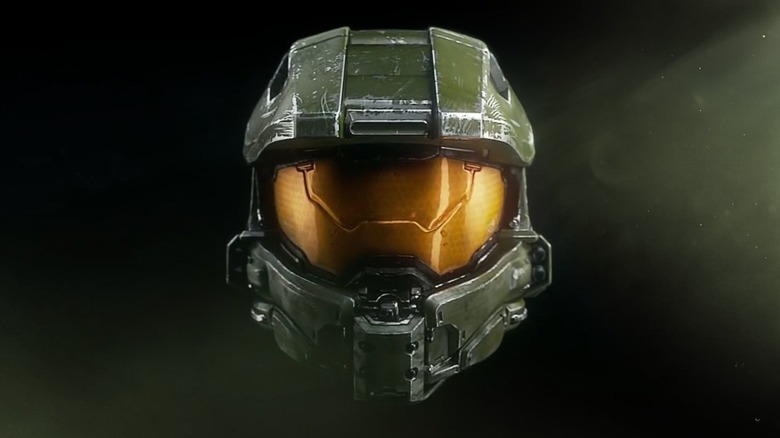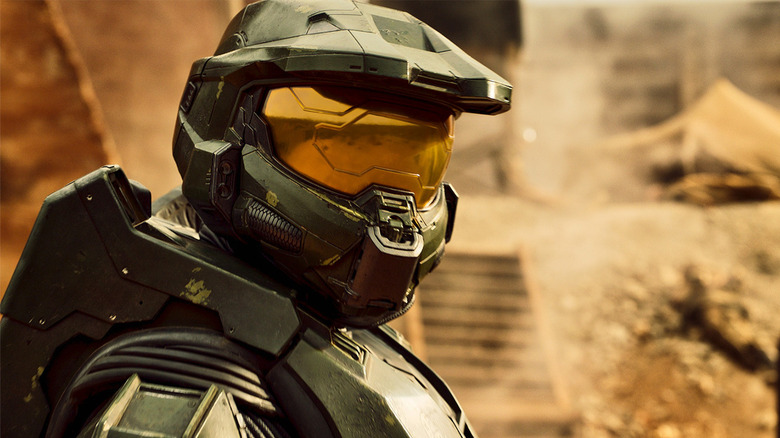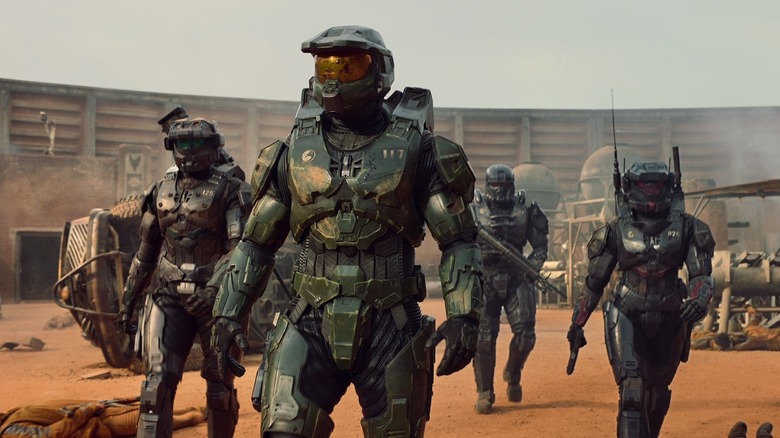Halo Star Pablo Schreiber Explains Why It's Crucial That Master Chief Remove His Helmet [Exclusive]
It's been 21 years since "Halo: Combat Evolved" introduced the world to Master Chief's intimidating, stoic and, yes, expressionless visage. We know his name is John and that he's a Spartan (no relation to Sylvester Stallone in "Demolition Man"). He's an augmented human who has been trained since early childhood to be a great warrior, but beyond that we, the player, knew precious little about our big green avatar other than he was superhuman and could land a sticky bomb on a Grunt's face 20 feet away.
Now, the "Halo" games have doled out little bits and pieces of the main character's backstory here and there, but for the most part Master Chief has been defined by mystery. You never see his face in the game. There have been cheeky little moments where you think you're going to and then the camera finds an angle in a cut scene just at the right time to keep him hidden, no more defined than a gravelly voice and an orange visor.
That's kind of the point in a video game like this. He's supposed to be an avatar for the player with a hint at something greater to make you really feel like a badass while playing the game.
So the number one question on the minds of "Halo" fans as we approach the debut of the Paramount+ big budget streaming series is a relatively simple one: are we gonna see that face or not? Well, our own Ryan Scott interviewed the man behind the mask, Pablo Schreiber, at SXSW where the first episode just played in front a crowd and got the full answer.
To see or not to see, that is the question
Schreiber, who had splashy appearances in "American Gods" and "Orange is the New Black," didn't dance around the question, to his credit, even if what he had to say might spark a debate amongst "Halo" purists.
"I always knew that the helmet off was going to be a big part of the show because, just quite frankly, it's the only way to tell this story in long-form television format. The game was made as a first person shooter, where you're meant to believe that you're the Master Chief. So the character was kept vague for that reason, and you infuse the character with your own personality and your own subtleties. This is a TV show being made for long term success. In order to do that, you have to bring the audience along with you. And really, the only way of doing that is seeing the face, knowing how the character's feeling about things. That's how you empathize with them. That's how you go along with them on the journey.
So it was always a necessary thing, and it was a necessary thing to do early, to get the audience comfortable with going on this journey. Also because the character has been kept vague for so long. The process of the first season is really the process of John learning who he is as a human being. So, 'Who is the Master Chief?' is kind of the big question that we're going to fill in, in the first season. It's through the process of him learning about himself, and therefore, we, as audience members, will all learn about that along with him."
Peeking under the hood
It's hard to argue with the logic that playing a video game is a hugely different form of immersive storytelling than passively watching a film or TV series unfold and that they can't get away with keeping their main protagonist a faceless mystery forever. Even in the established "Halo" universe there have been novels and comic books that have fleshed out Master Chief.
But I will say I think too much weight is put into seeing a hero unmasked. "The Mandalorian" has proven having a helmeted lead character can be just as engaging as, say, Robert Downey Jr spending 90% of his superhero time with Iron Man's faceplate lowered. And I don't lose my sense of Peter Parker in the "Spider-Man" films when they go 10-plus minutes with him in the tights.
That said, maybe the reason Mando works so well within the context of that series is that we do get a handful of moments where we see beneath the beskar and see the man behind the mask. We've never really had a Western show fully carried by a symbol and not a face, at least not that I can think of. If they were ever going to try it, it would have been with this "Halo" show, but it sounds like one of the driving forces isn't playing up the mystery of our lead character, but figuring him out.
As someone who binged the first three "Halo" games and had memorable LAN parties (kids, ask your parents what that means) back in the day and still has a little PTSD from those first few encounters with The Flood, all I can say I want out of this show is a fun time and to see some imagery from the games. I really don't care if we see Master Chief's face, but do prepare for the online discourse around this revelation because it's for sure coming.


